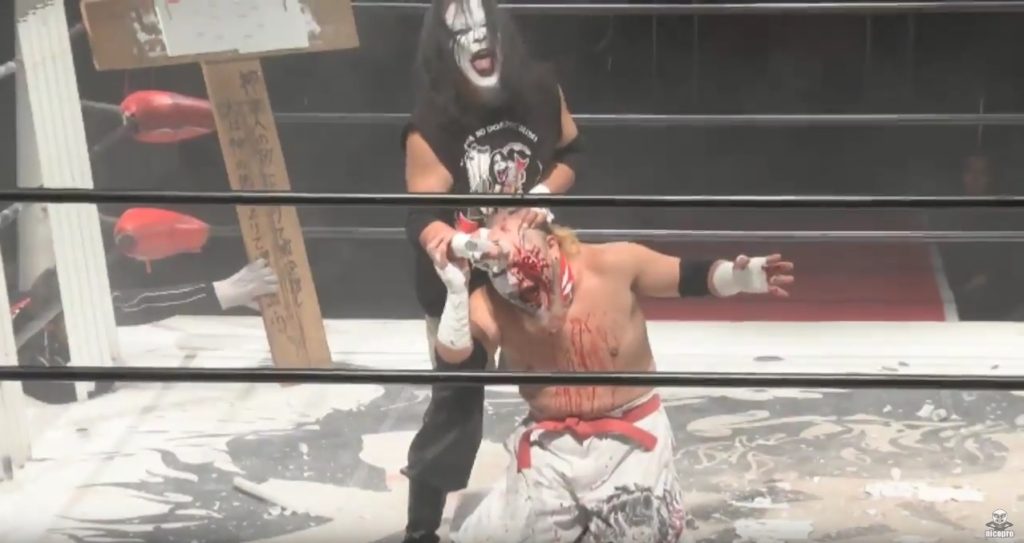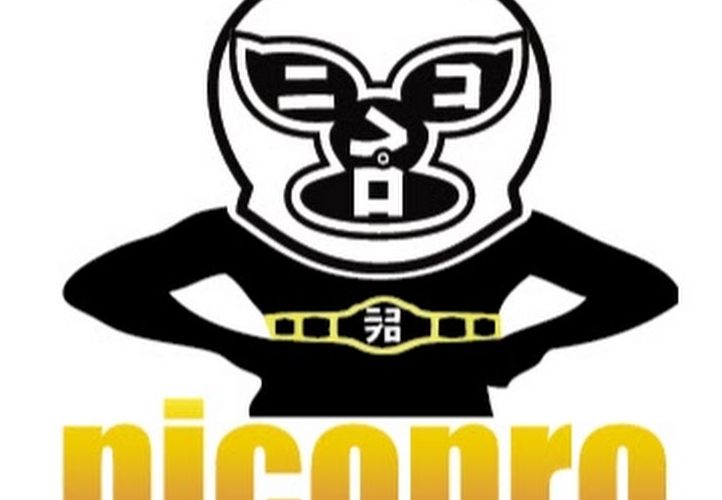I’ll try not to do a lengthy introduction with each new installment of this series, but very quickly: Adventures in NicoPro is all about using the NicoPro YouTube service to begin my trip into the unknown after leaving WWE behind. I’m very often going to be unfamiliar with the wrestlers involved and have limited, if any, knowledge of the promotions either.
The journey continues…
Big Japan Wrestling @ 1st Ring 10/19/2017
I’m not completely in the dark when it comes to extreme violence in a wrestling context. I’ve watched a fair amount of ECW over the years. That includes the DVD compilation WWE put out of their “most violent matches”. The DVD featured the Rotten Brothers’ Taipei Deathmatch, and the Sabu Vs. Terry Funk barbed wire match. The latter match features a moment where Sabu’s arm is ripped open by barbed wire, which he treats by taping his wound shut before continuing the match.
When it comes to Japanese deathmatch wrestling, I’m a complete novice. I’ve heard about the style based on reputation, and Atsushi Onita is someone I know people speak about reverently. But I’ve only ever watched a few of his matches, with no real insight as to where these matches fit into his career or whether they’re considered particularly important or even good, as compared to other of his matches.
I get the sense that the match I’m going to cover here is something else entirely. The wrestlers involved are completely unknown to me. The match went on last. But based on conversations I’ve seen online, that doesn’t explicitly mean it was the most important match on the show, where deathmatches are involved.
Lighttube & Four Corners of Pain Deathmatch: Jaki Numazawa vs. Kenji Fukimoto
Jaki Numazawa comes out dressed as a sort of surrealist Pope figure, like a grimy, blood-soaked version of the singer from heavy metal band Ghost. His opponent, Kenji Fukimoto, looks like the elder statesman of some twenty-plus year old black metal band. Corpse-painted face, long-ish hair, and a general presence that indicates that he’s bizarrely at ease with being a representation of grisly excess made flesh. Fukimoto breaks a florescent light tube over his head and smiles after entering the ring. The crowd, for their part, appear to be unmoved by this display.
Numazawa and Fukimoto stare at each other for a moment once the bell rings. It has the awkward tension of two kids too nervous to ask each other to dance in middle school. They’re both hesitant, until Fukimoto finally drags a trash can containing light tubes to the center of the ring. Numazawa politely waits and even moves out of Fukimoto’s way as he drags the can towards the center of the ring.
The two each grab a light tube, and Numazawa offers Fukimoto the first shot, and Fukimoto is happy enough to oblige . Numazawa sells the shot lightly before returning fire, which Fukimoto sells like he bumped his head on an open overhead cabinet door. They continue on like this until they switch to breaking light tubes over their own heads, more concerned with proving their pain thresholds than actually trying to win the match. Numazawa takes this demonstration a step too far and cuts himself below the eyes, which gives Fukimoto the opening he needs to throw the rest of the light tube trash can at Numazawa, and the match begins in earnest.
The match has plenty of instinctively repulsive imagery. Stabbing each other in the head with broken light tubes, Fukimoto taking a blade hidden behind a cross left in a corner of the ring and dragging it across Numazawa’s forehead. At another point, a thin cross with some kind of sharp objects glued to it comes into play, as Fukimoto is slammed into it ass-first. Numazawa follows this by prying some of the sharp objects off of the cross, and then using his fist to pound them into Fukimoto’s arms and forehead, puncturing him.

A Grim Spectacle
The effects of these savage assaults are largely sold in a similar way from both men: mouth agape, body stiffened by pain and shock. As they continued on, blood ran down Numazawa’s face and into his mouth, which Fukimoto eventually mirrored. Fukimoto landed a back body drop and a DDT, and until that point you’d be forgiven for forgetting that is a wrestling match. From there, they wrestled a relatively normal match for a couple of minutes. But as you might have guessed, the match soon returned to the gruesome brutality of its early minutes, and eventually Numazawa powerbombed Fukimoto onto a pile of light tubes for the win.
As the match went on, it struck me as odd that these wrestlers were so careful and light whenever the match wasn’t focused on weapons and blood. I watched Numazawa pound sharpened metal into his opponent’s forehead, cutting him deeply enough to send blood down his face, only to tap his opponent gently with punches a short time later. There’s a complete disconnect in intensity from the vicious bloodletting aspects of the match compared to the “standard” wrestling side of things. It’s possible that my feelings regarding this kind of selective application of violence kept the match from having its intended effect on me. I don’t want these wrestlers in greater danger than what they’re already subjecting themselves to. But for the sake of consistency, shouldn’t strikes and lariats and other moves mirror the ferocity of the grim spectacle that surrounds them? Otherwise, what’s the point?
The Sorrow of Bleeding For Bored Indifference
I’m hesitant to analyze the crowd’s response—though I’m going to—for a couple of reasons. First is that given the nature of how this was recorded, it’s possible that they were louder than what I could pick up on. Second, I don’t have enough context to know whether this is actually a typical response given the wrestlers’ normal spot on the card, or how they’re viewed popularity-wise in the first place. With that said, as someone watching from an outside perspective, the experience of people flatly watching as two men mutilate themselves before them, with no horror, no shock and, as best I can tell, very little bloodthirsty cheering or shouting in response, is surreal.
I’m open to the idea that I might be misinterpreting the overall presentation here because I simply don’t have the experience or context needed to frame this correctly, and if that’s the case, I’m willing to accept that. But if I’m right, and something this violent really did get what amounts to a collective shrug from people who paid to see it; the whole thing needs to be reexamined. Either by the wrestlers who couldn’t get any kind of emotional reaction from their audience, or from the promotion, who may have misjudged the audience wants to see out of matches like this.
Ultraviolent matches can and should be emotionally and/or viscerally impacting. When they they fail to connect in either way, it can be a remarkably depressing experience to watch. When someone willingly lets their flesh be cut for an audience, and a stray voice can be heard reverberating through the building in response, it’s time to regroup and figure out what went wrong.
For these reasons, this match was both melancholy and grotesque, just like the song below.
